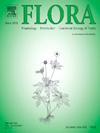Morphological variation in bulliform phytoliths at different rice growth stages
IF 1.7
4区 生物学
Q3 ECOLOGY
引用次数: 0
Abstract
Studying morphological changes in bulliform phytoliths in rice during different growth periods can provide essential information for understanding phytolith formation mechanisms and rice domestication processes. In this study, we analysed changes in the size and fish-scale decorations of rice bulliform phytoliths during a complete growth and development cycle. We then explored the underlying plant physiology, agricultural practices, and other factors that influence rice bulliform phytolith formation. From the transplanting stage to the ripening stage, the fan width (HL) and fan length (VL) of bulliform phytoliths tended to increase, decrease, and increase, reaching a maximum at the ripening stage (HL = 40.1 ± 6.1 μm, VL = 39.7 ± 5.3 μm). From the transplanting stage to ripening, the proportion of the long-stalked phenotype decreased significantly, and that of the short-stalked phenotype increased significantly. The proportion of rice bulliform phytoliths with ≥ 9 fish-scale decorations was 0 % at the transplanting and tillering stages and then increased from 42 % to 74 % from the elongation to ripening stage, with an average of 57 % for the four periods (elongation to ripening). The results of this study enhance the existing data on rice phytolith morphology, providing valuable insights into the morphological changes associated with rice domestication.
水稻不同生长阶段牛皮状植金石的形态变化
研究水稻在不同生长时期的斗形植生石形态变化,可为了解植生石形成机制和水稻驯化过程提供重要信息。在本研究中,我们分析了水稻在一个完整的生长发育周期中,其牛头状植金石的大小和鱼鳞状纹理的变化。然后,我们探讨了影响水稻牛头状植金石形成的潜在植物生理、农业实践和其他因素。从移栽阶段到成熟阶段,牛头状植球的扇形宽度(HL)和扇形长度(VL)呈上升、下降和上升趋势,在成熟阶段达到最大值(HL = 40.1 ± 6.1 μm,VL = 39.7 ± 5.3 μm)。从移栽期到成熟期,长柄表型的比例明显下降,短柄表型的比例明显上升。在移栽和分蘖期,鱼鳞纹饰≥9个的水稻胚芽鞘比例为0%,从伸长期到成熟期,鱼鳞纹饰≥9个的水稻胚芽鞘比例从42%增加到74%,四个时期(伸长期到成熟期)的平均比例为57%。本研究的结果丰富了现有的水稻植被形态数据,为了解与水稻驯化相关的形态变化提供了宝贵的信息。
本文章由计算机程序翻译,如有差异,请以英文原文为准。
求助全文
约1分钟内获得全文
求助全文
来源期刊

Flora
生物-植物科学
CiteScore
3.30
自引率
10.50%
发文量
130
审稿时长
54 days
期刊介绍:
FLORA publishes original contributions and review articles on plant structure (morphology and anatomy), plant distribution (incl. phylogeography) and plant functional ecology (ecophysiology, population ecology and population genetics, organismic interactions, community ecology, ecosystem ecology). Manuscripts (both original and review articles) on a single topic can be compiled in Special Issues, for which suggestions are welcome.
FLORA, the scientific botanical journal with the longest uninterrupted publication sequence (since 1818), considers manuscripts in the above areas which appeal a broad scientific and international readership. Manuscripts focused on floristics and vegetation science will only be considered if they exceed the pure descriptive approach and have relevance for interpreting plant morphology, distribution or ecology. Manuscripts whose content is restricted to purely systematic and nomenclature matters, to geobotanical aspects of only local interest, to pure applications in agri-, horti- or silviculture and pharmacology, and experimental studies dealing exclusively with investigations at the cellular and subcellular level will not be accepted. Manuscripts dealing with comparative and evolutionary aspects of morphology, anatomy and development are welcome.
 求助内容:
求助内容: 应助结果提醒方式:
应助结果提醒方式:


